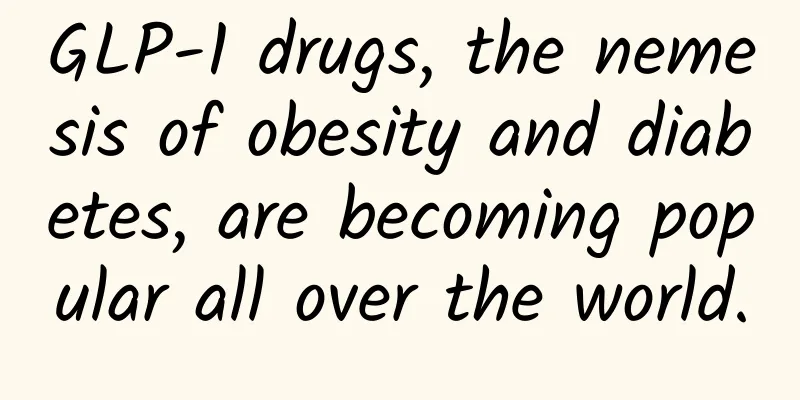How to formulate dietary policies? How to eat healthier? All these are inseparable from nutrition research.

|
Produced by: Science Popularization China Author: Li Juan (PhD in Life Sciences) Producer: China Science Expo Editor's note: In order to unveil the mystery of scientific work, the China Science Popularization Frontier Science Project launched a series of articles called "Me and My Research", inviting scientists to write articles themselves, share their scientific research experiences, and create a scientific world. Let us follow the explorers at the forefront of science and technology and embark on a journey full of passion, challenges, and surprises. In our Chinese daily life, "eating" not only meets basic needs, but is also a culture and art, and even has a healing effect. Since ancient times, we have had the saying that "medicine and food have the same origin", and food is regarded as a means of health preservation and disease prevention. (Here is a special reminder, if you need to take medicine after being sick, you must follow the doctor's advice.) In the white paper "Dietary Therapy Strategies and Actions for Chronic Disease Prevention and Treatment in the New Era" released by the Chinese Nutrition Society in June 2024, it is mentioned that yam and white lentils can strengthen the spleen, papaya and fennel can soothe the stomach, and wolfberry and black sesame can nourish the liver and kidneys. Common ingredients and their effects. A wide variety of dishes (Photo source: veer photo gallery) The combination of traditional dietetic wisdom and modern nutrition research has elevated dietetic culture to a new level. Nutritional theory involves multiple fields, including physiology, medicine, chemistry, etc. Its research methods include statistics, epidemiology, chemical analysis, experimental medicine, etc. From the metabolic research of a single nutrient to the exploration of regional dietary patterns; from observational research investigating dietary health to rigorous clinical randomized controlled trials, Chinese and foreign nutrition scientists have tried to explore the mystery between food and health from multiple angles and levels. The Exploration of Healthy Chinese Food Given the diversity and complexity of Chinese cuisine and the significant differences between Chinese and Western dietary habits, the evidence-based dietary approach that has been validated mainly in Western societies is difficult to implement in China. Even in China, dietary habits in different regions vary according to local customs. In recent years, dietary research with Chinese characteristics has flourished, providing a high-quality theoretical basis for exploring a healthy diet suitable for Chinese residents. 1. Traditional Jiangnan Meal A clinical intervention trial conducted by Chinese scientists in 2022 showed that China's "Traditional Jiangnan Diet" can better control blood sugar and weight, and improve cardiometabolic risks, which is comparable to the "Mediterranean Diet", a world-recognized benchmark for healthy dietary patterns. The study also pointed out that the nighttime blood sugar fluctuations of participants following the Traditional Jiangnan Diet were significantly smaller than those of participants following the Mediterranean Diet, which has the advantage of maintaining blood sugar homeostasis. In this study, 253 overweight/obese participants aged 25 to 60 were randomly assigned to three groups: a Mediterranean diet group, a traditional Jiangnan diet group, and a control diet group. What are the characteristics of these diet groups? The Mediterranean diet group is characterized by the use of extra virgin olive oil, marine fish, nuts, and whole grain products such as buckwheat bread and pasta; the traditional Jiangnan diet refers to the daily dietary pattern in the Yangtze River Delta region, which is characterized by a large amount of fresh fruits and vegetables, fish and shrimp, and soy protein, the use of vegetable oils such as rapeseed oil, more brown rice, and a preference for steaming, light and low-salt, small and varied cooking methods; the control diet group represents the daily diet in large cities, with a higher proportion of saturated fat, pork, and refined rice. Various soy products (Photo source: veer photo gallery) During the six-month dietary intervention trial, participants used a weight scale connected to a mobile application and wore a smart wristband to monitor weight fluctuations and maintain their daily physical activity levels. The study preliminarily demonstrated the health benefits of the traditional Jiangnan dietary pattern. In 2023, researchers further studied the impact of the traditional Jiangnan diet. The results showed that the blood lipid composition of the three different dietary groups changed, especially the traditional Jiangnan diet group. The changes in its blood lipid characteristics were related to the improvement of risk factors for type 2 diabetes. The study showed that changes in blood lipid characteristics of the three groups of participants were related to the proportion of fish and red meat intake, and specific lipid components were significantly correlated with pancreatic islet function, insulin resistance and diabetes risk: lipids related to fish metabolism were associated with better pancreatic islet function and lower diabetes risk, while lipids related to red meat metabolism were associated with reduced insulin sensitivity and a higher diabetes risk. This study further supports the health benefits of the traditional Jiangnan diet. 2. Chinese heart-healthy diet In the experimental design plan published in 2020 to evaluate the "Chinese Healthy Heart Diet", researchers designed recipes according to the four major Chinese cuisines: Shandong cuisine, Huaiyang cuisine, Cantonese cuisine, and Sichuan cuisine. Their common characteristics are low fat, low sodium, high potassium, high protein, rich in fiber and high carbohydrates. Three meals a day are prepared by chefs hired by the study and provided free of charge to participants living in Beijing, Shanghai, Guangzhou and Chengdu. Cantonese-style morning tea (Photo source: veer photo gallery) The results of the first Chinese Heart Healthy Diet Trial in 2022 showed that the Chinese Heart Healthy Diet can effectively lower the blood pressure of patients with hypertension. 265 adults aged 25-75 years participated, with systolic blood pressure between 130 and 159 mmHg, and were randomly assigned to the intervention group of the Chinese Heart Healthy Diet or the control group of the conventional local diet. The trial lasted for 28 days. The systolic and diastolic blood pressures of the Chinese heart healthy diet group decreased by 15.0 mmHg and 6.7 mmHg, respectively, while those of the control group decreased by 5.0 mmHg and 2.8 mmHg, respectively, showing that the intervention group had a better blood pressure lowering effect. Further analysis showed that the Chinese heart-healthy diet group had significantly reduced serum total cholesterol and cardiovascular disease risks. This trial once again demonstrated that well-designed, delicious and affordable Chinese meals can bring health benefits and enhance people's confidence in controlling blood pressure and cholesterol through "diet therapy". The above intervention studies all use randomized controlled trials, which is one of the "gold standards" for verifying causal relationships and has become a reliable reference for determining the association between specific dietary factors and chronic disease risks. In this type of study, participants are randomly assigned to different intervention groups (such as different dietary plans, nutrient supplements, etc.) and the health outcomes of each group are compared. This research design can minimize the impact of bias and confounding factors, thereby more accurately evaluating the effectiveness of intervention measures. Complex and unique nutritional research In addition to intervention studies, other sources of nutritional evidence include observational studies, animal experiments, and in vitro tests. However, observational studies are a research method that nutrition relies heavily on. Researchers collect information on people's dietary habits, lifestyles, and other influencing factors through questionnaires, and analyze the data to evaluate the relationship between nutrition and health. Observational studies include prospective cohort studies, retrospective cohort studies, and cross-sectional studies. Researchers must use a variety of analytical methods to eliminate the influence of confounding factors, such as recall bias (people may not remember what they ate in the past) and individual differences (cultural background, economic status, education level, and living environment may affect people's dietary habits and health status at the same time), which may affect both dietary habits and health status. In recent years, many studies have been of varying quality, often with contradictory conclusions. In addition, some media have misrepresented or exaggerated the facts, misreporting the correlation conclusions found in observational studies as causal relationships. For example, a study investigating the correlation between the intake of nut snacks and weight loss was reported as "eating nuts can help you lose weight"; a study on the correlation between chocolate intake and diabetes risk was reported as "eating chocolate can prevent diabetes"... This will undoubtedly cause confusion and misunderstanding among the public, causing many people to lose trust in the conclusions of nutrition research and even question the scientific nature of the entire discipline. nut (Photo source: veer photo gallery) So, since observational studies cannot conclusively determine causality, can we rely solely on intervention studies? Why do we still need large-scale observational studies? This is because observational studies of populations can help us discover problems and preliminarily determine whether food and disease are related; intervention studies are more expensive and time-consuming, and need to be based on valid observational studies to ensure that the right questions are asked. In addition, nutrition intervention trials themselves face many challenges and are very different from drug intervention trials. Therefore, it is impossible to simply borrow the design model of drug intervention trials for the following reasons: First, in drug trials, it is relatively simple to distinguish between treatment and placebo groups, and a double-blind method can be used to reduce bias and expectation effects. In contrast, designing an appropriate control group and implementing a blind method in dietary studies is more challenging because it is necessary to consider the balance of nutrient doses and calories in the control group while keeping the participants and researchers as unaware as possible. Taking the Chinese Heart Healthy Diet Trial mentioned above as an example, due to practical operational limitations, it is difficult for chefs, nutritionists and researchers to implement the blind method. However, in order to ensure the objectivity of the research results, the staff responsible for the results evaluation remained blind to the intervention allocation. At the same time, the research team tried their best to blind the participants by not revealing group information, arranging the two groups to dine in different rooms, providing the same dishes but different nutritional content (such as a healthy version of Kung Pao Chicken and a regular version of Kung Pao Chicken), and sometimes even using foods that looked similar but had different nutritional content. Kung Pao Chicken (Photo source: veer photo gallery) Meals for both the intervention and control groups were prepared and distributed in the research center kitchen. Participants mainly ate on site. If they could not eat on site, they could take the food home, but they were required to take photos of the remaining food for evaluation. Participants were required to ensure that at least 80% of their meals were eaten on site each week, otherwise they would be considered non-compliant. Second, in intervention trials that last a long time, subjects may not follow the assigned intervention for various reasons. For example, in the Jiangnan dietary intervention trial, 20% of the participants dropped out, 30 refused to follow up, and the rest dropped out because they did not like the assigned diet. Researchers need to design special measures to improve the compliance of participants. Third, compared with drugs, the effects of diet on health are usually more subtle and slow. Drugs can significantly change physiological indicators in a short period of time, while diet may require long-term, continuous intake to observe its effects on health. Drugs usually target a single system/pathway in disease pathology, while nutrients are usually systemic, affecting multiple systems and affecting disease risk through multiple pathways. Moreover, other interfering drugs can be excluded or controlled in drug trials; but in nutritional intervention trials, synergistic or antagonistic effects with other nutrients are usually not fully considered. Fourth, randomized controlled trials often need to be conducted under strictly controlled conditions, which may be different from people's daily living habits. Therefore, the results of the study may not fully reflect the situation in real life. Therefore, nutrition research is highly complex and uncertain, and it is often difficult to draw firm conclusions from a single study result. It is necessary to use observational studies, intervention studies, and other types of studies to understand the mechanisms by which diet affects health. Through well-designed intervention studies, the results of multiple types of studies are comprehensively analyzed to draw important conclusions about the relationship between diet and health. These conclusions can not only provide personal dietary recommendations, but are also crucial for the formulation of clinical guidelines and public health policies. Policy making relies on high-quality research Early nutritional health research effectively reduced vitamin deficiencies such as beriberi (vitamin B1 deficiency), pernicious anemia (vitamin B12 deficiency), scurvy (vitamin C deficiency) and rickets (vitamin D deficiency), demonstrating the importance of nutritional research in improving human health. In fact, the results of nutritional research not only guide people's daily healthy dietary habits, but also have important significance for guiding clinical practice. First of all, nutritional support is crucial for clinical patients to recover from diseases, especially chronic diseases that are closely related to nutritional metabolism. In terms of guiding clinical practice, the European Society for Clinical Nutrition and Metabolism (ESPEN), an authoritative academic organization, has issued a number of clinical nutrition practice guidelines based on the latest research evidence, covering multiple fields such as tumors, liver diseases, critically ill patients, parenteral nutrition for children, and nutrition for hospitalized patients with comorbidities, providing an important basis for clinical nutrition practice in my country. Clinical nutritional intervention usually includes three methods: oral feeding, enteral nutrition, and parenteral nutrition. For patients who eat orally, doctors or nutritionists will guide them to have a balanced diet based on their dietary habits and reduce high-fat, high-energy foods. For those who cannot eat orally, enteral nutrition can be used to directly deliver nutrients to the patient's stomach or small intestine through tube feeding methods such as nasogastric tubes or gastrostomy. If gastrointestinal function is completely lost or long-term fasting is required, parenteral nutrition can provide patients with scientifically proportioned nutrients through intravenous infusion of nutrient solution. Enteral nutrition diet (Photo source: veer photo gallery) Secondly, high-quality nutrition research evidence is also the basis for countries to formulate public health policies. Professor Hu Bingchang of the Harvard School of Public Health demonstrated through three examples how nutritional epidemiology research can help formulate and improve health policies. First, observational studies in the UK in the 1970s showed that folic acid intake was associated with the risk of neural tube defects , and subsequent case-control studies and prospective cohort studies further confirmed this association. In 1996, the US FDA approved the fortification of cereal products with 0.14 mg of folic acid per 100 g of flour, which has been enforced since 1998. This measure has reduced the incidence of neural tube defects by 19% within 5 years. Second, sugary drinks are related to obesity . Many studies have shown that the intake of sugary drinks is related to obesity, type 2 diabetes and heart disease. Therefore, some countries and regions have begun to impose consumption taxes on sugary drinks to reduce intake. For example, after Mexico imposed a tax on sugary drinks in 2013, the sales of sugary drinks decreased; most schools in the United States stopped selling sugary drinks; Boston banned the sale of sugary drinks in all public buildings, etc. Third, trans fatty acid intake is associated with an increased risk of heart disease . This research result prompted the US FDA to require the listing of trans fatty acid content on food labels in 2003, and finally took measures to phase out trans fatty acids in 2013. Local governments such as New York City have banned restaurants and schools from using trans fatty acids. It is estimated that about 72% of trans fatty acids in the US food supply have been removed, and blood lipid levels in children and adults have improved. If trans fats are banned nationwide, it is estimated that 6,480 to 12,960 deaths from ischemic heart disease will be reduced each year. In formulating dietary guidelines, dietary advisory committees in various countries strictly review and screen high-quality research data and provide consensus reports to reduce public confusion and clarify the direction of healthy diet. In recent years, my country has formulated a series of policies to meet the challenges of chronic diseases and ensure that scientific insights are transformed into practical health care practices. Since 2023, the National Health Commission has organized the formulation and publication of eight dietary guidelines for common chronic diseases in adults, encouraging primary health workers to refer to relevant guidelines for guidance. At the same time, the "Healthy China Action (2019-2030)" as a national strategy aims to enhance public health awareness and reduce the incidence of chronic diseases. The release of the white paper "Dietary Therapy Strategies and Actions for the Prevention and Treatment of Chronic Diseases in the New Era" highlights the role of dietary therapy, dietary therapy and nutritional therapy in the prevention and treatment of chronic diseases, and provides guidance for primary medical and health institutions and food nutrition production companies. The new 2022 edition of the "Dietary Guidelines for Chinese Residents" recommends following the eight principles of a balanced diet: food diversity and reasonable combination; balance between eating and exercise, and healthy weight; eat more fruits and vegetables, dairy, whole grains, and soy; eat fish, poultry, eggs, and lean meat in moderation; less salt and oil, control sugar and limit alcohol; eat regularly and drink enough water; know how to cook and choose, and know how to read labels; use public chopsticks to share food and eliminate waste. Eight principles of a balanced diet (Photo source: veer photo gallery) A more scientific nutrition plan allows us to eat healthier The combination of traditional dietary wisdom and modern nutrition research reveals the complex connection between nature, humans, food and health. Modern science is revealing the mysteries of traditional eating habits. With the application of advanced technologies such as microbiome in the field of nutrition, more personalized nutrition plans will be developed in the future, and we will have a deeper understanding of the impact of food on human physical and mental health, so as to make more informed dietary choices. We need to be open-minded to accept scientific guidance, make rational dietary choices, eat healthily and happily! References: 1. Luo Y, Wang J, et al. Isocaloric-restricted Mediterranean diet and Chinese diets high or low in plants in adults with prediabetes. J Clin Endocrinol Metab. 2022 May 17:dgac303. 2. Luo Y, Sun L, Wu Q, Song B, Wu Y, Yang X, Zhou P, Niu Z, Zheng H, Li H, Gu W, Wang J, Ning G, Zeng R, Lin 1;46(9):1691-1699. 3. Xie W, Wang Y, Sun J, et al Protocol of a multicenter, single-blind, randomized, parallel controlled feeding trial evaluating the effect of a Chinese Healthy Heart (CHH) diet in lowering blood pressure and other cardiovascular risk factors. BMJ Open 2020;10:e036394. 4. Wang Y, Feng L, Zeng G, Zhu H, Sun J, Gao P, Yuan J, Lan X, Li S, Zhao Y, Chen X, Dong H, Chen S, Li Z, Zhu Y, Li M, Li X, Yang Z, Li H, Fang H, Xie G, Lin PH, Chen J, Wu Y; China: Multicenter, Single-Blind, Randomized, Parallel Controlled Feeding Trial. Circulation. 2022 Jul 26;146(4):303-315. 5. Li Q, Feng L, Sun J, Zhu H, Zeng G, Gao P, Yuan J, Zhao Y, Li S, Lan X, Chen X, Li Z, Chen S, Dong H, Li M, Li X, Yang Z, Li H, Xie G, Wang Z, Lin PH, Chen J, Wang Y, Wu Y; randomized controlled trial. Am J Clin Nutr. 2024 Feb;119(2):333-343. 6. Vitolins MZ, Case TL. What Makes Nutrition Research So Difficult to Conduct and Interpret? Diabetes Spectr. 2020 May;33(2):113-117. 7.Satija A, Yu E, Willett WC, Hu FB. Understanding nutritional epidemiology and its role in policy. Adv Nutr. 2015 Jan 15;6(1):5-18. 8. Kerna NA, Holets HM, Hafid A, Flores JV, Carsrud NDV, Nwokorie U, Rashid S, Anderson II J, Waugh S. A Comprehensive and Practical Guide to Clinical Nutrition in Medical Practice. EC Gastroenterology and Digestive System 8.7 (2021): 76-86. |
<<: "What's my zodiac sign?" There is actually a national standard for this!
>>: The Taklimakan Desert changes into a sea of snow with one click! | Environmental Trumpet
Recommend
Search engine promotion guide for the logistics industry!
Today, I would like to discuss with you the promo...
Is less code cleaner?
In my eyes, clean code is simple and easy to unde...
Are there natural disasters in the universe? The Sun: Look at me, I'm awesome!
With the start of a new solar activity cycle, the...
The tragedy of Android phones: high scores but not as smooth as iPhones
Recently, Lei Jun's Weibo post about "Wh...
5 steps to prepare for a successful microservices journey
[Editor's Note] This article introduces 5 pre...
Why was iPhone 4 abandoned?
Apple did not completely ignore the consumer deman...
Insect antennae are so weird
Source: www.countytimes.co.uk Huer Insects are ve...
Antibiotics and anti-inflammatory drugs, what is the difference? Many people take them wrongly
gossip "Cold, fever, toothache, sore throat,...
Academician Ouyang Ziyuan: The moon is already "dead", why do we still need to explore it?
Have you ever thought about this question: Will a...
Interpreting ASP.NET 5 & MVC6 Series (4): Core Technology and Environment Configuration
asp.net 5 is the next generation of asp.net. This...
Seven things you need to know about Google's reorganization
[[144912]] Google, the world's largest Intern...
The merger of Feifan Automobile is almost certain. No matter who breaks the impasse, time is no longer on SAIC's side.
Recently, there are reports that SAIC Feifan Auto...
What is the difference between people who take a walk after a meal and those who don’t? Pay attention to this point!
Walking is a simple and effective form of exercis...
How many Western elves do you know who are related to "heavy snow"?
It is snowing heavily today. Here are some typica...









